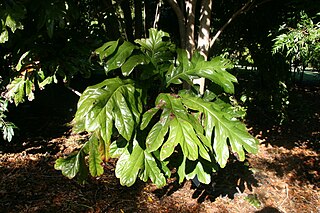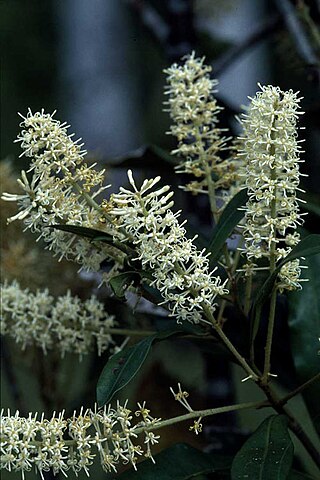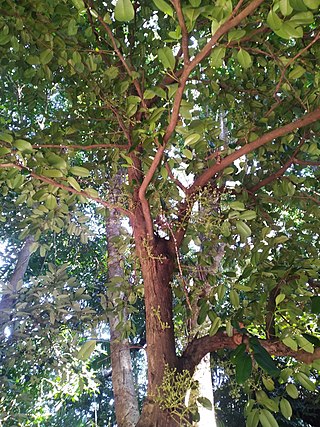
Araucaria bidwillii, commonly known as the bunya pine, banya or bunya-bunya, is a large evergreen coniferous tree in the family Araucariaceae which is endemic to Australia. Its natural range is southeast Queensland with two very small, disjunct populations in northeast Queensland's World Heritage listed Wet Tropics. There are many planted specimens on the Atherton Tableland, in New South Wales, and around the Perth metropolitan area, and it has also been widely planted in other parts of the world. They are very tall trees – the tallest living individual is in Bunya Mountains National Park and was reported by Robert Van Pelt in January 2003 to be 51.5 m (169 ft) in height.

Grevillea, commonly known as spider flowers, is a genus of about 360 species of evergreen flowering plants in the family Proteaceae. Plants in the genus Grevillea are shrubs, rarely trees, with the leaves arranged alternately along the branches, the flowers zygomorphic, arranged in racemes at the ends of branchlets, and the fruit a follicle that splits down one side only, releasing one or two seeds.

Agathis robusta, commonly known as Dundathu pine, kauri pine, Queensland kauri (pine), Australian kauri (pine) or smooth-barked kauri, is a coniferous tree in the family Araucariaceae. Although sometimes called a pine it is not a true pine, having leaves rather than needles. It has a disjunct distribution, occurring in eastern New Guinea and New Britain in Papua New Guinea and Queensland, Australia.

Athertonia is a monotypic genus of plants in the family Proteaceae. The sole described species is Athertonia diversifolia, commonly known as Atherton oak, athertonia, creamy silky oak or white oak. It is endemic to a small part of the Wet Tropics of Queensland, Australia. A relative of the macadamia, it has potential in horticulture and the bushfood industry.

Hicksbeachia is a genus of two species of trees in the family Proteaceae. They are native to rainforests of northern New South Wales and southeastern Queensland. They are commonly known as red bopple nut or beef nut due to the bright red colour of their fruits.

Lophostemon confertus, is an evergreen tree native to Australia, though it is cultivated in the United States and elsewhere. Common names include brush box, Queensland box, Brisbane box, pink box, box scrub, and vinegartree. Its natural range in Australia is north-east New South Wales and coastal Queensland but it is commonly used as a street tree in Sydney, Melbourne, Perth and other cities in eastern Australia.

Bleasdalea is a genus of flowering plants in the family Proteaceae.

Chionanthus ramiflorus, commonly known in Australia as northern olive or native olive, is a species of plants in the olive family Oleaceae. It is native to India, Nepal, northeastern Australia (Queensland), New Guinea, the Philippines, southern China and Taiwan.

Gevuina avellana is an evergreen tree, up to 20 meters tall. It is the only species currently classified in the genus Gevuina. It is native to southern Chile and adjacent valleys in Argentina. It is found from sea level to 700 meters above sea level. Its distribution extends from 35° to 44° south latitude. The composite leaves are bright green and toothed, and the tree is in flower between July and November. The flowers are very small and beige to whitish, are bisexual and group two by two in long racemes. The fruit is a dark red nut when young and turns black. The peel is woody. It can grow up straight or branched from the soil, making up either a tree or a shrub.

Grevillea hilliana, commonly known as white silky oak, white yiel yiel, Hill's silky oak and grey oak, is a species of flowering plant in the family Proteaceae and is endemic to eastern Australia. It is a tree with lance-shaped to oblong or lobed adult leaves and cylindrical clusters of large numbers of white to pale green flowers.

Grevillea glossadenia is a species of flowering plant in the family Proteaceae and is endemic to Queensland, in northeastern Australia. It is an erect shrub with more or less elliptic leaves and deep yellow-orange to orange-red flowers.
Beilschmiedia bancroftii is a tree species in the family Lauraceae. It is native to Queensland in Australia. Common names include yellow walnut, yellow nut and canary ash.

Opisthiolepis is a monotypic genus of trees in the macadamia family Proteaceae. The sole species is Opisthiolepis heterophylla, commonly known as blush silky oak, pink silky oak, brown silky oak or drunk rabbit. It was first described in 1952 and is endemic to a small part of northeastern Queensland, Australia.

Catalepidia is a monotypic genus in the family Proteaceae which is endemic to Queensland, Australia. The sole described species is Catalepidia heyana, commonly known as Hey's nut oak. It is a medium sized tree growing up to about 18 m (59 ft) tall, and is found only in upland rainforest above 600 m (2,000 ft) on granite soils, ranging from the Windsor Tableland to the Atherton Tableland.

Carnarvonia araliifolia, commonly known as the red oak, red silky oak, Caledonian oak or elephant's foot, is the sole species in the monotypic genus Carnarvonia, a member of the Proteaceae plant family. It is endemic to the rainforests of northeastern Queensland.

Nothorites is a monotypic genus in the macadamia family Proteaceae. The sole species, Nothorites megacarpus, is endemic to the wet tropics rain forests of northeastern Queensland, Australia.

Grevillea erythroclada, commonly called needle-leaf grevillea, is a species of flowering plant in the family Proteaceae and is endemic to northern Australia. It is a shrub or small tree with divided leaves, the ultimate lobes linear to more or less cylindrical, and clusters of cream-coloured to pale yellow flowers.

Syzygium branderhorstii, commonly known as the Lockerbie satinash, is a small tree in the family Myrtaceae found in New Guinea, the Bismarck Archipelago, Solomon Islands, Santa Cruz Islands, and northern Queensland, Australia. It is cauliflorous, producing large inflorescences from the trunk. The fruits are eaten by brush turkeys.

Polyosma rhytophloia, commonly known as wrinkled bark polyosma, is a plant in the family Escalloniaceae which is endemic to parts of eastern Queensland, Australia. It was first described in 1926.

Cupaniopsis flagelliformis, commonly known as brown tuckeroo or weeping flower tamarind, is a tree in the lychee, guaraná and maple family Sapindaceae which is endemic to eastern Australia. It is a small tree that inhabits drier or seasonal rainforests.




















